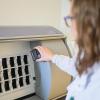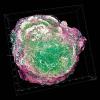Following a complete overhaul, one lab is on track to hit the 98% target for 10-day turnaround times by 2025. Quality, Training and Transformation Manager Paul Chenery talks through the ambitious journey.

Across the NHS, meeting national key performance indicators (KPIs) is challenging, regardless of the sector. This is multifactorial, including but not exclusive to funding, estate/infrastructure, recruitment and retention. Histopathology is no different. With significant shortages from technical laboratory staff to experienced consultant colleagues, ageing populations, post-COVID recovery and a national push to reduce backlogs, the pressure and expectation is greater than ever.
There are many nuances to histopathology turnaround time (TAT) targets, but broadly they were to achieve 80% diagnostic biopsy reports in seven calendar days and 90% of all histology sample reports in 10 calendar days. There are challenges around achieving these targets outside of the usual staffing pressures, including:
- TAT starts from when the sample is taken from the patient
- Traditionally operating on a Monday–Friday 9–5 service
- Manual processes (limited automation)
- Multistep processes, which include lengthy overnight tissue processing
- Additional testing required following first analysis.
The majority of trusts are not achieving these targets consistently and face the daunting prospect of increased workload and greater complexity with the transition to digital pathology.
It has been recently announced that the government has reviewed cancer targets across the NHS and rationalised them, with the focus now being on a 28-day faster diagnostic standard (FDS). As histopathology plays a crucial role in diagnosis and would account for a significant portion of this 28-day timeline, the Transforming histopathology – six point plan has been produced by NHSE. It highlights six areas of concentration. It is important to note that while these areas have been identified, not all will receive additional funding.
Two of the most costly (laboratory estate/infrastructure and automation) will receive no funding, with the expectation monies are found by each individual trust. The stark reality nationally of the post-pandemic financial position means that any traction within these areas will be extremely limited and will impact on labs’ ability to achieve. Within this plan are the new targets and expectations of histopathology departments in England:
- 70% of all sample reports available in 10 days by March 2024
- 80% of all sample reports available in 10 days by September 2024
- 98% of all sample reports available in 10 days by March 2025.
The key messaging here is the focus on all samples being available within a timeframe, moving away from a specific focus on sample groups. The change in concept aligns with the idea of a “first-in, first-out” (FIFO) principle, which is proven to be an effective mechanism for throughput of workload in a wide range of industries. This also addresses the NHS need to reduce the backlog of patients with benign or low-priority treatment pathways. FIFO is the founding principle for the transformational changes made here at Nottingham University Hospitals NHS Trust (NUH).
Here at Nottingham

Nottingham has a workforce of 32 whole-time equivalent (WTE) consultants, 170+ technical and admin and clerical staff delivering 73,000 cases per annum.
In 2022 the laboratory was facing consistent block backlogs of up to 3000, immunohistochemistry TATs of 9–14 days and overarching civility concerns with regard to low morale, stress, overworked staff, lack of training, limited opportunities and poor staff retention. Our overall TATs for patient results in 10 days ranged from 27% to 40% – a far cry from the expected 98% in 10 days by 2025. To compound issues, the department was successful in receiving just short of £1m to increase staffing, but the anticipated improvement did not materialise.
While the above does not make for pleasant reading, I am pleased to say this is no longer the case. This article is an 18-month story of how bravery, embracing change, looking at things differently and enormous workforce dedication has turned things around to make NUH a leading centre for delivery of patient care.
Digital pathology
NUH was part of the PathLake+ project, which is an extension of the original PathLake project aimed at upscaling digital pathology within NHS trusts in England. This would see an improvement for networking between multiple trusts to address several identified needs, including a shortage of pathologists nationally, produce cost savings, and facilitate the implementation and adoptions of paradigm-shift AI-based algorithms.
Conversion to digital pathology, in conjunction with Indica Labs and Halo AP case management platform, has led to improvements in the quality of patient care and efficiency gains in the use of pathologists’ time. This has permitted greater subspecialisation, easy access to second opinions and the additional resilience created when multiple units work together to balance workloads.
Successful implementation required a rethinking of workflow through the laboratory, so that it wasn’t seen as a cumbersome add-on step. It was vital that we reimagined workflow to integrate this new technology seamlessly, ensuring resilience to continue for business as usual. A number of anticipated issues needed to be addressed prior to implementation of the digital pathology system and any costs associated with them were included in the business case:
Barcoding of slides – The digital pathology system needed to be interfaced with the laboratory information management system (LIMS) to pull the patient demographics and details of the slides in every case. Each slide required a unique 2D barcode to enable the scanner to recognise it and place the whole slide image (WSI) in the slot allocated within the system. Consequently having end-to-end barcoding in place was an essential prerequisite for implementation. Currently, version 4 Connect software, which is part of our Vantage tracking system, acts as an interface between LIMS and the digital pathology information management system (DP IMS).
“It was vital that we reimagined workflow to integrate this new technology”
Information flow – To realise the full benefit of digital pathology we had to look at it as more than just a digital microscope. All of the information required to allow authorisation of a report needed to be added to the record in the LIMS prior to WSI being reviewed by a pathologist.
Flow of slides for scanning – Slides are generated at multiple site locations within the laboratory. It was vital the locations of scanners were considered to reduce the “waste walks”.
Desktop integration with the LIMS reporting system – This refers to the ability to open the reporting page of cases directly from within the same case in the digital reporting system (and vice versa). This ensures no efficiency or reporting safety is lost. Most digital pathology systems do not interface directly with LIMS in this way, so middleware systems need to be considered as part of any business cases.
IT networking capacity – Throughout the process, trust IT was engaged. This is vital to ensure that local area network (LAN) can cope with the expected traffic without slowing service provision.
Validation of consultant reporting – Of all steps, this is crucial to the speed and confidence in the system. The consultant teams need to be fully engaged in the selection and development of the digital pathology pathways. At NUH we had a dedicated clinical lead who was fully engaged and provided one-to-one training for our other 31 consultant colleagues. It is important to remember to listen and address individual concerns whilst ensuring a standardised pathway for the laboratory is maintained. Most digital pathology systems allow for an element of personalisation for day-to-day reporting. Variations need to be captured when applying for UKAS accreditation.
The method for validating individual consultants for primary diagnostic reporting was agreed and recorded within the quality management system (QMS).
Quality, training and continual improvement
One of the biggest lessons from the last 18 months has been to invest in quality, training and continual improvement. While this seems like an obvious statement, I know from experience that when under pressure to deliver practical diagnostic work, these very areas are the first to be left behind. Yet, they are the foundations of any laboratory and what we are fundamentally measured against.
Invest in quality – UKAS accreditation is the cornerstone of laboratory practice in the UK. At NUH we have a strong culture of quality embedded into working practice. It is the responsibility of all to maintain quality within working practices and participation in the maintenance of documentation. The Cellular Pathology Quality Team at NUH ensures the department maintains an exacting standard that led to zero findings in relation to the QMS at our recent UKAS visit. Any change projects are delivered through rigorous quality standards.
Invest in training – It is our goal to remove the glass ceiling for staff development and to provide as many opportunities for personal achievement as possible. The department has a dedicated training team who will uphold the highest standards and ensure that we are not only meeting the expected level, but exceeding it and pushing the boundaries of accomplishment. While occasionally it may seem like minor inconvenience to train, the benefits far outweigh negatives. Some of the key areas of improvement were to:
- Establish a 12-month rolling programme of CPD lectures
- Establish “Fundamentals of histology workshops” for staff members interested in progression at medical laboratory assistant and associate practitioner level
- Establish a Lean Six Sigma Yellow Belt programme for continual improvement
- Generate numerous trainee positions from graduate to specialist
- Support numerous apprentice biomedical scientist positions
- Redefine the Team Leader roles to create ownership and accountability
- Create roles such as Expert and Advanced Dissectors
- Support attendance at leadership courses.
Invest in continual improvement – Cellular pathology is undergoing its greatest period of change. To deliver change effectively, individuals need the time for thought and contemplation. Too often change projects are expected to be delivered as an addition to existing roles and remits. In October 2022, NUH decided to think differently, with the appointment of a Transformation Manager and Advanced Biomedical Scientist – Transformation Lead. The department invested time and money to ensure that they had the skills to deliver the necessary change at pace. Both members of staff were trained to be “Black Belts” in Lean Six Sigma, which is an internationally recognised qualification that marks a professional’s capability to implement improvement processes in the workplace.
Creative thought and resetting the minimum standard
With the introduction of digital pathology, increasing workload pressures, and further advances such as AI and increased automation on the horizon, we had to reimagine how the department tackled day-to-day workflow. As we left the pandemic, where the department experienced significantly reduced activity, behind it was important to revisit and reset the minimum standard for a business-as-usual workload.
Kaizen events – These are traditionally short-term creative thought and implementation sessions to improve an existing process. The department held two events to map out and improve the entire workflow. There was a loose structure to the event, outlining the vision for the day, but the primary message was that nothing was off the table. The event was not the time to think small; it was our opportunity to think big and break barriers. The Kaizen group had representation from all members of the department, from laboratory assistant to senior management. The event was there to foster creative thought and provide a safe space for discussion/debate.
This event highlighted two main areas for improvement: procedures and environment.
Procedures
Redefining urgency: FIFO – NUH Histopathology now operates on the FIFO principle. While this may seem like an obvious principle – i.e. the oldest work is dealt with first – it is actually fairly uncommon for laboratories nationally – the majority use a priority-based system. While the majority of samples are entered into the LIMS system when they arrive, they are then channelled through various different priority systems, dependent on sample type. This is currently driven by the numerous cancer target pathways throughout the NHS. We discovered through data collection this actually had a negative impact on overall TAT when looking to achieve the expected percentage for all samples. However, if all samples are given some level of urgency then nothing becomes urgent.
One of the greatest barriers we had to overcome was the fear that because we weren’t “prioritising” samples, it could have a detrimental impact on patient care. We have found that the best way to achieve overall TAT is to follow the FIFO principles. When integrating digital pathology this allows for simple workflow pathways minimising areas of wait steps and complications around specimen reordering. FIFO principles follow the process through to reporting, made simpler through digital pathology. All scanned cases are automatically ordered oldest first, unless specifically escalated by the laboratory.
Scheduled rapid tissue processing – Traditional tissue processing within histopathology departments consists of overnight programmes, meaning work needs to be batched into large amounts. We have introduced and validated scheduled rapid tissue processing. Every day certain samples are processed on either a two-hour or four-hour tissue processing cycle. This gives the department the ability to turnaround a sample in <8 hours from receipt to results, which would have otherwise been >24 hours. Additionally the continual flow with rapid tissue processing means work is evenly distributed throughout the day.
“If all samples are given some level of urgency then nothing becomes urgent”
Wait steps – Due to the manual nature of histopathology sample preparation, there are many steps which require an individual to progress. Through process mapping we discovered these seemingly insignificant amounts of time over a week, month and year added up and resulted in workstations being inactive for prolonged periods of time. We introduced the role of “core support”. This role has a schedule throughout the day of tasks, which means they fulfil the wait steps and prevent the workstations becoming inactive.
Scheduled sample collection – As described early in the article, the TAT is determined from the time the sample is taken to the authorising of the report. The average time for a sample to be received by a department was 1.3 days. We have introduced a scheduled collection round multiple times a day, meaning samples from clinics and the central reception arrive in a timely manner.
Environment
It was identified that the laboratory environment was cluttered and in some cases not fit for purpose. A full workflow mapping exercise was conducted, designating workstations and specific areas with a clearly identified purpose. Areas were organised through the 5S principles (sort, set in order, shine, standardise and sustain).
Outcome and next steps
- No sample backlogs
- Consistently achieving over 70% of all samples in 10 days
- Improved morale and staff retention
- Full integration of digital pathology.
Next steps
- UKAS accreditation of digital immunofluorescence (first in the UK)
- Implementation of AI algorithms
- Development of the continual improvement team within Cellular Pathology
- Review existing pathways and look to apply Six Sigma.
Timeline
- 2021 to Jan 2023 Digital pathology implementation phase August 2021 Delivery of equipment (Hamamatsu Scanners s360 x3 and S60 x 2)
September 2021 – November 2021 Validation of equipment
January 2022 Started scanning all slides
January 2023 UKAS accreditation for primary diagnostic reporting
September 2023 Implementation of digital immunofluorescence (IMF)
October 2023 100% pathologists validated
October 2023 ~50% workload glassless workflow (HMDN, GI & Derm)
April 2024 100% glassless workflow - July 2022 Redefining roles and skill mix for higher scientific staff roles
- August 2022 Finished recruitment from business case investment
- October 2022 Creation of Transformation team
- January 2023 Kaizen events
- February 2023 Implementation of lean workflow
Feedback
Throughout this process it has been important to be open and transparent with what we were aiming to achieve with multiple feedback forums. It is one thing for me to tell you about the changes but below I have included quotes from members of staff affected by the changes.
“A department that I am proud to work for, where opportunities and development are in abundance and where I would be happy to have my loved one’s sample handled,” Niamh Longwill, Trainee Expert Scientist Dissector.
“Digital pathology has completely revolutionised our service. Not only has it improved our service for the patients, but it has also positively impacted other aspects in the laboratory, such as quality and training. I now couldn’t imagine working in our laboratory without it,” Alice Edwards, Specialist Biomedical Scientist.
“The changes have allowed the team to see broad potential where traditional methods are now aligned with automation and digital capabilities. The new process standard provides rapid turnaround and ease of access for case review with the same quality methodology foundations. The process is now streamlined to allow expedited movement of specimens, improving day-to-day operation and ultimately the experience of the people we care for,” Nicole Crow, Biomedical Scientist.
“Continual improvement can’t be achieved without change. Often change meets resistance, however that can be overcome by positive change management and supportive leadership aligned with staff engagement,” Daniela Magalhaes, Advanced Biomedical Scientist.
“I am thrilled to shout from the rooftops about the groundbreaking triumphs of our Cellular Pathology Department. Surpassing NHSE’s 70% target well ahead of the 2024 deadline, we are not just hitting milestones, we are setting a world-class standard for patient care, right here in Nottinghamshire.
“Against the backdrop of the NHS’ financial constraints, this isn’t just doing more with less, it is redefining excellence. The team has shown a level of engagement, morale, and ambition that is nothing short of world class. Their ownership over their work and improvements has been awe-inspiring.
“What is equally exciting is our outlook. With the integration of digital pathology, I am supremely confident that we will scale new heights, reaching the 80% target within 10 days by September 2024. We are not just delivering care; we are revolutionising it. Our achievements have made us a beacon for other labs keen to understand our recipe for delivering high-quality, person-centred care.
“To encapsulate this spirit of collective triumph and forward momentum, I am reminded of Winston Churchill's words: ‘Success is not final, failure is not fatal: It is the courage to continue that counts.’ Here is to a fantastic team that has exemplified courage, turning what seemed impossible into a new standard for healthcare in Nottingham,” Sharif Goolam-Hossen, Pathology Directorate Manager.
It is difficult to sum up the department’s journey, but we welcome visits from any laboratories who wish to discover more around digital pathology and lean laboratory workflow. Feel free to email me on [email protected].
Image credit | Shutterstock




